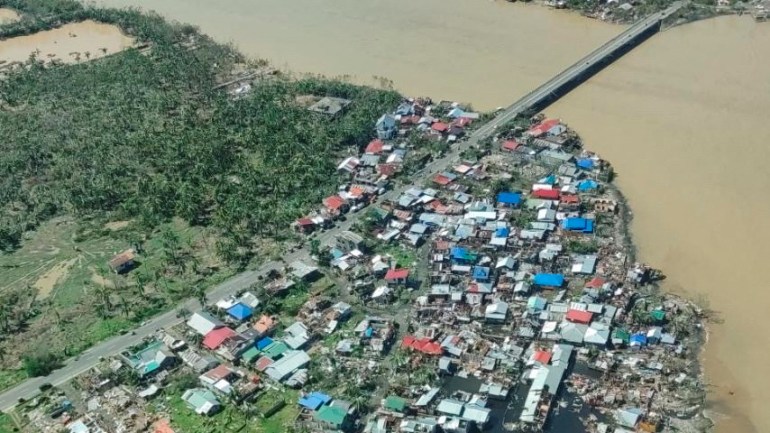‘Desperate’ need for water, food in typhoon-hit Philippines | Weather News
More than 18,000 soldiers and emergency personnel are joining search and rescue efforts in the Philippines, after the strongest typhoon to hit the country this year caused “severe damage” in central and southern regions.
The deployment on Saturday comes as the death toll from Typhoon Rai rose to 18 and people in affected regions pleaded for help.
The storm, known locally as Odette, was a super typhoon when it slammed into the eastern island of Siargao on Thursday, packing maximum sustained winds of 195 kilometres per hour (120 miles per hour).
More than 300,000 people were forced to flee their homes as the storm ravaged the central and southern regions of the country, knocking out communications in many areas and toppling concrete power poles.
Mark Timbal, a spokesman for the national disaster agency, said “there has been severe damage” in Siargao island as well as in the city of Surigao on the neighbouring island of Mindanao.
Communications are still down in both Siargao and in Surigao, he told the AFP news agency.
Philippine Coast Guard has shared photos on social media showing widespread destruction around Surigao city, with roofs torn off buildings, wooden structures shattered and palm trees stripped of fronds.
Aerial footage showed swathes of rice fields under water.
 A general view of the damages caused by Typhoon Rai seen in Siargao Island, Surigao del Norte, Philippines, December 17, 2021 [Philippine Coast Guard/Handout via Reuters]
A general view of the damages caused by Typhoon Rai seen in Siargao Island, Surigao del Norte, Philippines, December 17, 2021 [Philippine Coast Guard/Handout via Reuters]In Dinagat, an island province west of Siargao, Vice Governor Nilo Demerey told broadcaster ABS-CBN that the the storm had left at least six people dead.
That takes the overall death toll to 18, with the disaster agency also reporting seven missing and two injured.
“Odette was so strong,” Demerey said, using the local name for the typhoon.
Residents “are trying to repair their houses because even our evacuation centres were torn down. They can’t seek refuge anywhere else… everything was destroyed.”
Al Jazeera’s Jamela Alindogan, reporting from the Philippine capital, Manila, said the situation was “quite desperate” in the affected provinces.
“People we’ve spoken to say they are in need of water, medicine, shelter, and basic items like blankets and sleeping mats. Many hospitals in these areas are partly damaged. Some patients there are also in need of food, medicine and other supplies,” she said.
“But the issue here is that the travelling points – the airports and ports – have largely been destroyed.”
Officials are still trying to assess the extent of the damage, including the number of people who have died, she said, but that effort has been hampered by damage to communication lines.
Those who’ve survived are “grateful to be alive”, Alindogan said, “but they fear for the coming months because their livelihoods have been completely obliterated”.
“A lot of the affected areas, Siargao, Bohol, Leyte, were just slowly recovering from this pandemic. These are provinces very much dependent on tourism for their livelihoods,” she said. “These are also the same areas that over the past few months have had the highest incidences of hunger, because of the lockdowns and the recession, and they had been hoping to be able to begin recovering economically.”
The Philippine weather agency said the typhoon is now easing.
After lashing Palawan island on Friday, Rai has emerged over the South China Sea on Saturday and is heading towards Vietnam, it said.
Rai hit the Philippines late in the typhoon season – most cyclones typically develop between July and October.
Scientists have long warned that typhoons are becoming more powerful and strengthening more rapidly as the world becomes warmer because of human-driven climate change.
The Philippines – ranked as one of the world’s most vulnerable countries to the impacts of climate change – is hit by an average of 20 storms and typhoons every year, which typically wipe out harvests, homes and infrastructure in already impoverished areas.
